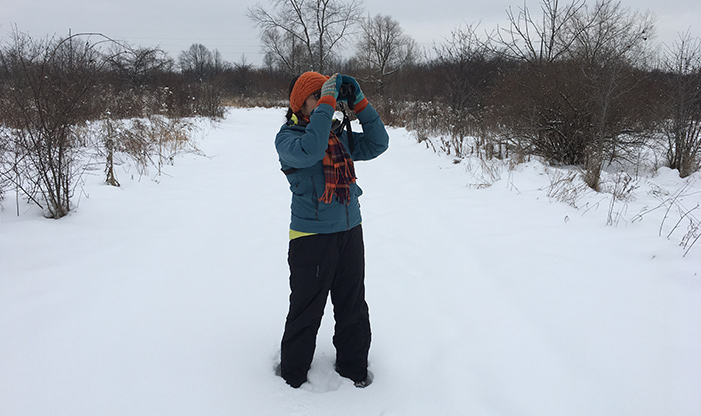Written with contributions from Zoe Finney, Milwaukee CBC Compiler, and Jean Strelka.
The National Audubon Society’s Christmas Bird Count has been an ongoing project for 120 years, and has grown steadily since its inception. It started on Christmas Day in 1900, when the conservation movement was in its early stages, and is one of the longest running citizen science endeavors in history. You can be a part of it by participating in the Milwaukee Christmas Bird Count, which takes place on Saturday, December 14. It’s a great way to contribute to the understanding of the avian population while having a good time with fellow birders.
Ornithologist Dr. Frank M. Chapman, an early officer in the Audubon Society, originally proposed a new tradition for the holidays. At the time, Christmas hunts were common. Chapman suggested counting birds instead of hunting them. On that first day, he inspired 27 birders to join 25 bird counts, whose combined tallies were 90 species.
In 1910, ten years after it began, the count consisted of 117 circles with 183 participants, and by 1940, there were just over 1800 circles. Today, there are over 1,900 circles in the U.S. with approximately 60,000 people counting birds within them.
How Birds Are Counted
Bird data is gathered within defined circles, which take up a 15-mile diameter area where volunteers count birds for a census. Nationwide, established circles remain in the same place and can’t be moved because the count provides a snapshot of that particular area’s bird population. Milwaukee is just one of many circles in Wisconsin included in the count.
The Milwaukee Circle encompasses much of Milwaukee, reaching into Wauwatosa, West Allis, Bay View, Brown Deer, and Bayside including Schlitz Audubon. Each circle is divided into smaller segments where individuals or groups of birders are assigned to survey. Part of the Milwaukee circle includes Lake Michigan, and some birders will spend hours behind their scopes to identify and count birds that are found on the lake.
How Information is Used
Imagine all of the data about birds collected from the beginning of the project through today! Over the years, the data gathered has been used in over 300 scientific papers, and has helped scientists understand habitat, population dynamics, climate change, and assess the overall health of bird populations while helping to guide conservation decisions.
When combined with other surveys such as the North American Breeding Bird Survey, and eBird data, it provides information on how bird populations have changed in space and time for the last 100 years. The National Audubon Society, US Fish and Wildlife Service, and the North American Bird Conservation Initiative have all used data from Christmas Bird Counts in their vital reports.
Being Part of an Annual Event
Birders return to the count every year, to support this worthy project while also having fun together. In 2018, 71 birders in Milwaukee participated in the annual count, each possessing varying levels of experience from between a couple of years to a couple of decades. One participant has been tallying bird populations for over 40 consecutive years! Some dedicated birders even participate in multiple counts around the area in addition to Milwaukee.
In Milwaukee’s count from 2018, the most populous bird was the Herring Gull with 3,044 individuals, followed by the Canada Goose at 3,026. The most populous native passerine was the Dark-eyed Junco with 428 recorded birds. Other notable species from 2018 include a single Ruby-crowned Kinglet, one Gray Catbird, and one Surf Scoter.
Nationally, the species most recorded in recent tallies has been of the Red-winged Blackbird, which in 2016 was counted 8.9 million times. Part of the reason for the high number is the bird’s wide range and being found in large flocks. They are not the most populous bird, however, estimated at 99 million. The species with the highest population is actually the American Robin, which is usually found solitary or in smaller flocks and was counted 1.1 million times during the Christmas Bird Count, but whose estimated population is 160 million.
Participate in the Christmas Bird Count
When you sign up, you can be paired with someone who will complement your experience. Birders of all experience levels are encouraged. If you’d like to participate and can commit to birding on December 14, sign up for the Milwaukee Christmas Bird Count and contribute your observations. Get to know local birders while having a good time advancing a 120-year-old tradition.
Contact Zoe Finney, Milwaukee CBC Compiler, at zfinney@schlitzaudubon.org to join. There will be a post-count gathering at the Center at 4:00pm to tally observations and enjoy light refreshments.


